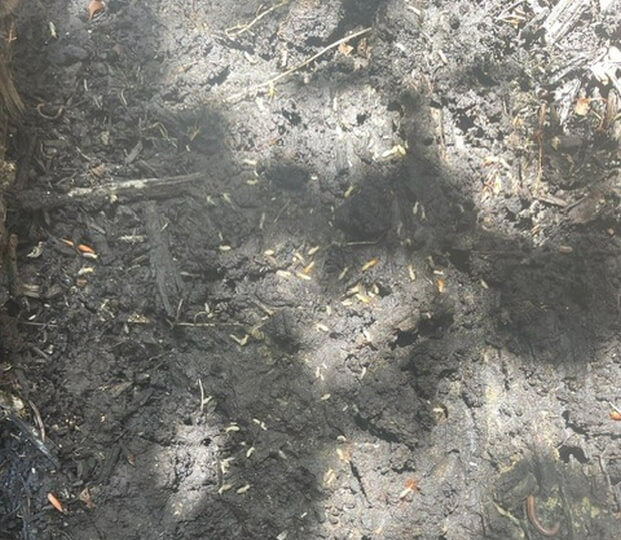For homeowners protecting your home termites is a top priority. Termites can go undetected for many years causing thousands of dollars in damage. In fact, in the United States termites cause over 5 billion dollars in damage annually.

At Animal Remover we pride ourselves on helping you protect your home from termites. We have all the tools, expertise, and talent to provide you best in class termite service. We use only the best industry leading treatment methods to prevent future termite infestations and to eliminate current termite infestations. At Animal Remover our termite services are customized to fit your needs. We tailer our specialized termite plans to each individual situation. We have our knowledgeable termite specialist staff standing by to assist you. We can usually accommodate same day termite service. We can also schedule next day termite service.
CALL US
513-324-9453

Like most pest management issues termite control starts with prevention. Prevention is important to prevent major termite damage. Unlike many other forms of damage termite damage often takes years to notice. When you do notice, its often too late and the termites have likely caused thousands of dollars in damage. We can provide you with termite bait stations and guarantee an infestation won’t occur.
CALL US
513-324-9453
Animal Remover's termite extermination and prevention services are full and comprehensive. When you book Animal Remover for your termite needs, you can rest easy knowing that we offer all of the following benefits, services, and more when it comes to dealing with termites:
Termite Inspection
Termite Extermination
Termite damage repair
Termite trenching and rodding
Annual Termite Inspection
Same Day Termite Inspection
Next Day Termite Treatment
Termite WDI Inspection
Termite Pest Control
Termite bait station installation
Termite annual equipment maintenance
Same Day Termite Services
Next Day Termite Inspection
Termite Treatment
Termite Management
Termite bait station rebaiting
Termite liquid residual application
Next Day Termite Services
Same Day Termite Treatment
Termites can squeeze their little bodies through a 1.5mm gap
Termites cause above 5 billion in damage each year
Like honey bees Termites work around the clock and do not sleep
Termite damage isn’t typically covered by home owners’ insurance
A termite queen lays around 2000 eggs in a single day
Termites are about 1/8 of an inch long
A termite queen can live up to 25 years
Worker termites are sterile and cannot breed
Solider termites have oversized mandibles that they use to defend the colony with
Termites require moisture and cellulose to survive
Reproductive are the only termites in the colony that are able to fly
Soldier and worker termites live for 1-2 years
Subterranean Termites are found in all of the United States except for Alaska
Georgia is the state with the most termite infestations
There are 2000 known species of termites. The most common wood destroying termites are damp wood termites, Formosan termites, drywood termites, and subterranean termites.
A queen termite lays an egg every 15 seconds.
A single termite consumes about 4 pounds of wood each year.
A single termite can consume about 5 grams of wood in one day.
Termites evolved in the late Permian period.
Termites communicate with pheromones and vibrations. When there is a threat in the colony the solider termites will release a pheromone and will hit their heads against the wall of the colony making a vibration to warn the other termites.
Termites are more activist during the warmer parts of the year like spring, summer, and fall.
Worker termites taste test all food before feeding it the queen.
Europe has about 10 different species of termites. The US has about 50.
Mud / shelter tubes present on the interior or exterior foundation walls.
Degradation of wood wall paneling.
The presence of winged swarmer termites inside or outside the home.
Seeing the presence of detached wings from swarmer termites.
Small holes in drywall or wood paneling with small amount of sand coming out of the hole.
Creaky or soft floors.
Paint peeling.
Hollow sounding wood.
Windows or doors that stick.
Don’t stack firewood near your home.
Make sure that there are no active sources of moisture around your home. This would include but not be limited to leaky hose faucets.
Have exterior termite bait stations installed to monitor and kill termites.
Don’t store wood or paper debris in your garage or basement.
Reduced moisture in your crawl space by installing plastic sheeting and encapsulating the crawl space.
Do not allow mulch to contact or be in close proximately to any wood on the structure of the home.
Don’t store wood piles in your garage.
Keep mulch fresh. Once mulch dries out it becomes more attractive to termites. Every other year you should dig out the old much, dispose of it, and install new mulch. The mulch on the bottom layer can dry out and attract termites and ants.
For active termite infestations and active termite colonies that have likely caused wooden or structural damage we highly recommend contacting a local pest control service. Often times these termite problems are far beyond DIY methods.
Diatomaceous earth – is a soft siliceous sedimentary rock that occurs naturally. It can be crumbled into a fine white to off-white powder. Diatomaceous earth does not have to be injected to work. It causes insects to die when they crawl through it. It absorbs the fats and oil in their skin and dries out their exoskeleton.
Boric acid – is colorless crystals or white powder that can be used as in insecticide.
Traps – glue boards or cardboard traps can be used to capture / attract termites.
UV light – Termites are very sensitive to sunlight. Bright and direct sunlight will kill them.
Orange oil – is an essential oil made from the rind of oranges. Orange oil can be applied to attics, and crawl spaces.
Nematodes – Parasitic nematodes feed on termites and can provide a good form of natural control.
